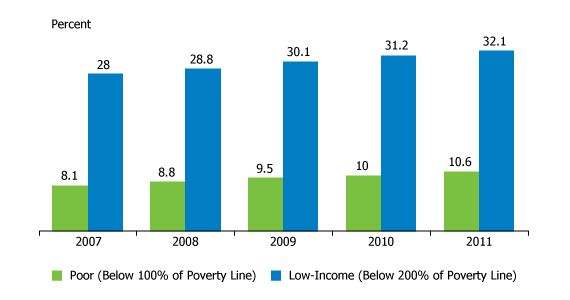Mark Mather
Associate Vice President, U.S. Programs

January 11, 2013
Associate Vice President, U.S. Programs
Economic security is out of reach for a growing number of working families in the United States, according to a new analysis of 2011 data from the U.S. Census Bureau’s American Community Survey. The number of low-income working families rose from 10.2 million in 2010 to 10.4 million in 2011, representing nearly one-third of all working families.
At the same time, the income gap between low-income working families and the nation’s wealthiest working families is widening, according to Low-Income Working Families: The Growing Economic Gap, by the Working Poor Families Project, supported by the Annie E. Casey, Ford, Joyce, and C.S. Mott foundations.
The report defines low-income working families as those earning less than twice the federal poverty line. In 2011, the low-income threshold for a family of four with two children was $45,622.
Between 2007 and 2011, the share of working families who are low income increased from 28 percent to 32.1 percent (see figure). In 2011, the top 20 percent of working families received 10.1 times the total income received by the bottom 20 percent of working families, up from 9.5 in 2007.
Working Families by Poverty Status, 2007-2011

Source: U.S. Census Bureau, American Community Survey.
“Although many people are returning to work, they are often taking jobs with lower wages and less job security, compared to the middle-class jobs they held before the economic downturn,” said Mark Mather, a report co-author and PRB associate vice president of Domestic Programs. Many of the fastest-growing jobs, such as those in the service sector, often require working nights and weekends, creating challenges for families who need child care, Mather said.
During the recent presidential election, low-income families were described as “takers” who do not work and rely on government aid, he noted. But the report shows that in 2011 more than seven in 10 low-income families were working. Also, half of all families with incomes below the poverty line ($22,811 for a family of four with two children) were working.
Other results from the report include:
“Policymakers stress the need to strengthen the middle class, but cutting programs and benefits that serve low-income working parents and their children would undermine that goal,” Mather said. The report calls on policymakers to support programs that provide education and training to low-income families. It also recommends policies that promote high-quality jobs with decent wages, paid sick days, and family leave; and policies that help low-income workers balance their work and family commitments.
